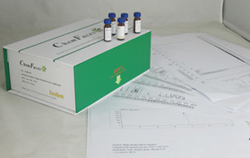Hot Products



| Catalog No. | Information |
| CFN90690 | Dimethyl lithospermate B Dimethyl lithospermate B is a highly potent natural antioxidant and antidiabetic polyphenol with unknown mode of action.Dimethyl lithospermate B slows inactivation of INa, leading to increased inward current during the early phases of the action potential (AP), might be an excellent candidate for a Na(+) channel agonist; it is effective in eliminating the arrhythmogenic substrate responsible for the Brugada syndrome and that it deserves further study as a pharmacological adjunct to implanted cardioverter/defibrillator usage. |
| CFN90164 | Dimethylacrylshikonin Dimethylacrylshikonin is a promising agent for developing an improved strategy for radiotherapy against tumors, it inhibits the proliferation of MCF-7 cells in vitro by inducing apoptosis through the downregulation of Bcl-2, upregulation of Bax and partial inactivation of the NF-κB pathway. Dimethylacrylshikonin inhibits agonist-induced relaxation at lower concentrations and induces vasocontraction at higher concentrations. |
| CFN90607 | Dimethylcurcumin Dimethylcurcumin is an androgen receptor degradation enhancer that effectively suppresses castration resistant prostate cancer cell proliferation and invasion. |
| CFN98014 | Diosbulbin B Diosbulbin B has potential anti-tumor effects which may be related to influencing the immune system for the first time, it also exhibits potential hepatotoxicity. |
| CFN98015 | Diosbulbin C Diosbulbin C has hepatotoxicity. |
| CFN99516 | Dioscin Dioscin has anti-obesity, antineoplastic, anti-cancer, anti-inflammatory, uricosuric and nephroprotective actions, it can potentially contribute to treatments for inflammatory diseases and atherosclerosis. Dioscin clearly protected PC12 cells and primary cortical neurons against OGD/R insult and significantly prevented cerebral I/R injury. It inhibited AMPK/MAPK pathway and regulated VEGFR2 and AKT/MAPK signaling pathways. |
| CFN99515 | Diosgenin Diosgenin possesses antivascular calcification , anti-osteoclastogenesis, anti-inflammatory and anticancer properties, it has favorable effects in the improvement of diabetes and regulation of lipid metabolism. Diosgenin treated inflammation-related disorders through the blockade of cAMP, PKA, cPLA2, PAK, Akt and MAPKs signaling pathways. Diosgenin may decrease the risk of developing dementia of opiate abusers with HIV infection and the ApoE4 allele. |
| CFN99760 | Diosgenin glucoside Diosgenin glucoside and other synthetic glycosides with similar activities may be of use in the management of hypercholesterolemia and atherosclerosis. |
| CFN90210 | Diosmetin Diosmetin has anti-osteoporosis, cytoprotective, antibacterial, anti-pigmentation, anti-inflammatory and antioxidant properties, it induces osteoblastic differentiation through the PKCδ-Rac1-MEK3/6-p38 and PKCδ-Rac1-MEK1/2- ERK1/2-Runx2 pathways.Diosmetin has intracellular antioxidant detoxifying effect, the mechanism is associated with both nonenzymatic and enzymatic defense systems.Diosmetin and luteolin exert synergistic cytostatic effects in human hepatoma HepG2 cells via CYP1A-catalyzed metabolism, activation of JNK and ERK and P53/P21 up-regulation. |
| CFN98502 | Diosmetin-7-O-beta-D-glucopyranoside Diosmetin-7-O-beta-D-glucopyranoside has antioxidant activity. |